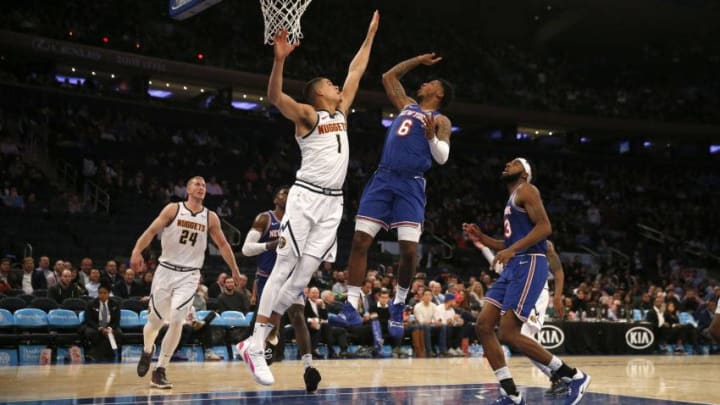The New York Knicks won back-to-back games for the first time this season when they defeated the Sacramento Kings by the score of 103-101 on Friday night. One of the keys to victory was the play of the entire Knicks bench, helping to swing momentum back towards New York.
Since Mike Miller has taken over as head coach, his most-used bench lineup has consisted of Elfrid Payton, Damyean Dotson, Kevin Knox, Bobby Portis, and Mitchell Robinson. In their limited time together, they’ve outscored opponents by an astounding 61.7 points per 100 possessions.
This number isn’t sustainable, but the eye test helps paint a better picture of a unit that has improved and is quickly creating amazing basketball chemistry. The Knicks have gone 2-2 with this new bench unit, and they’re a missed free throw away from potentially having a 3-1 record over their last four games.
Here’s how each bench player has impacted the team’s newfound competitiveness.
Elfrid Payton
Payton has been a solid contributor to the team ever since he’s returned following a hamstring injury, averaging 9.0 points and 4.4 assists per game on 47% shooting in December. His ability to drive into the paint helps open up the entire offense, forcing defenders to sag off their assignment to help defend him.
Slithering through for a quick two. pic.twitter.com/e4KZTI23dv
— NEW YORK KNICKS (@nyknicks) December 12, 2019
Another underrated aspect of his game is his defense, as Payton uses his hands to disrupt passing lanes and quick feet to stay in front of his matchup. Elfrid is currently averaging 1.8 steals per game, which would be the highest mark of his career.
At just 25 years old, Payton may have a future in the Big Apple if he can continue to produce at a high level off the bench.
Mitchell Robinson
After many expected Robinson to take a sophomore jump after a promising rookie season, the 21-year old’s play stagnated in the early part of this year. He still struggled heavily with fouls, limiting his impact on the court due to time spent in foul trouble.
Through December 2nd, Robinson was averaging just 20.5 minutes per game and recording an extremely disappointing 6.7 fouls per 36 minutes. However, the high-flying young center is developing budding chemistry with Elfrid Payton that is helping them both become better players.
When nobody guards Mitch ¯\_(ツ)_/¯ pic.twitter.com/fDvN14fhvm
— NEW YORK KNICKS (@nyknicks) December 14, 2019
Since Payton has returned to the team, Robinson is putting up numbers of 13.6 points, 7.4 rebounds, 1.6 blocks, and just 1.8 personal fouls per game. Even more impressive? He’s doing this all in 27.5 minutes per game.
With his early struggles in the rearview mirror, Robinson is beginning to take the second-year leap that many foresaw out of the former 2nd round pick.
Damyean Dotson
One of the New York Knicks’ largest problems is their lack of floor spacing, and Damyean Dotson deserved some of the blame. The former Houston standout looked off to begin the season, as concerns swirled around his offseason shoulder surgery, affecting his shot mechanics.
As a solid team defender with an above-average ability to finish at the rim, Dotson was able to keep his spot in the rotation despite his poor shooting. For reference, he shot just 27% from behind the arc during November.
Dotson has started to get his confidence back as of late. In his last eight games, he’s putting up numbers of 8.1 points and 2.0 rebounds per game while shooting 47% from the floor and 36% from deep. His shot is starting to return to form, as he’s displaying his unlimited range that he showed towards the end of last season.
https://twitter.com/nyknicks/status/1205712135059365888
Bobby Portis
Outside of a 28-point outburst against the Chicago Bulls in a revenge game against his former team, Bobby Portis’ play has remained relatively solid throughout the year. His defense has been poor, but pairing him with Mitchell Robinson in the frontcourt has helped mask some of his issues on that end of the court.
Portis struggled with isolating too much early on, but he’s starting to take a backseat and embracing his role as a spot-up shooter who occasionally posts up in the paint. He’s currently taking 33% of his shots from three point range, the highest mark of his career.
While his long range shooting percentage of 34.2% isn’t anything to write home about, his ability to space the floor has helped open up the offense for both starters and bench players alike.
Kevin Knox
Despite the improved play of the bench unit as a whole, Kevin Knox has continued to struggle. In the first ten games of the season, Knox was averaging 10.3 points per game while shooting 43.9% from three.
His numbers have dropped since then, with Knox now down to 7.2 points and 2.8 rebounds per game while posting a slash line of 36/33/65. Hopefully, he gets out of his slump soon, as the bench would benefit even more from his floor-spacing and cutting ability.
One silver lining has been his defense. While still struggling to match up with quicker guards, Knox has recorded seven blocks over his last seven games.
https://twitter.com/nyknicks/status/1204980784366575622
The New York Knicks have begun to gel as a team, and it’s showed in their competitive play. One reason for this has been the high productivity of the bench unit, and they likely haven’t even reached their full potential.
